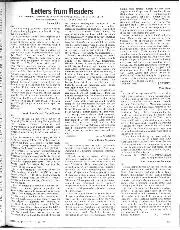
Historic rear-engined single-seaters
Sir, I write to you on the topical subject of "originality" in Historic Racing. Having followed the various editorial comments and correspondence in your excellent columns over the last few…
OUR COVER.
This month our cover illustration depicts T. Thistlethwavte competing in the R.A.C. T.T. in Ulster on his Merc.Mes. Readers are, no doubt, aware that this car made the fastest lap in the race at an average speed of over 74 m.p.h.
Well, the great Ulster T.T. is a thing of the past, and much that was said and written before the event has been shown to be ridiculous, while many warnings and forebodings uttered before the race are now seen to have been superfluous. It was not dangerous to start so many cars together, the course was not too tortuous, nor was it too fast for safety. The handicapping seems to have been remarkably efficient, and it looks as though one firm, who abstained from racing, owing to the system of handicapping, and one thing and another, might have won quite nicely, so near did a private entry of this marque arrive to that desired end.
My most outstanding impression of the whole race was the tremendous speed, tremendous size and almost incredible acceleration of Thistlethwayte’s big white Mercedes. There seems little doubt that this huge car was rather unsuited to the Ards circuit, and it speaks volumes for Thistlethwayte’s sportsmanship that not only did he enter and drive his car, but that he proceeded to put up the fastest lap of the race. From my own experience; of the 36/220 Mercedes, that lap cannot have been a dull business, on the whole. No, Sir!
One is inclined to speculate as to what would the race have been like had the official team of Mercs. been running. I think the spectacle of four or five thundering white monsters, with shrieking chargers, roaring upon my tail would have scared me into the nearest ditch, had I been at the wheel of another car.
I see that the Shell people have put on the market small phials of petrol for the replenishing of one’s cigarette-lighter, the phial to fit the waistcoat pocket.
I am able to state, however, that there is no truth in the rumour that pocket Pyrenes will shortly be available for the other waistcoat pocket, in case of emergency.
When I was at the Press View, on September 4th, of the forthcoming products of the Hillman Factory, the one item of the 1929 range which excited my interest was not on show, but the announcement was made that a 18 h.p. straight eight would be at Olympia, and at a price lower than any other eight-cylinder so far on the market. Well, we shall see what we shall see. The nearest approach to a sporting car, which I did see, was the new Husky (what a name!) Tourer, which looks very “Le Mans” in a Lagonda-cum-HadfieldBean sort of way. It has fine lines, an imposing bonnet with lamps fixed to a cross bar between wings, a cutaway side for the driver’s elbow, a flexible steering wheel,
and a side valve engine of 1954 c.c., with a four-speed box. The whole sells at f,385, and quite nice, too.
I was interested to hear Major Segrave holding forth in the train going down to the Hillman View, on the subject of traffic conditions and motoring progress in general. You may remember that in his book, “The Lure of Speed,” the Major put forth the somewhat unorthodox doctrine that it is better to negotiate crossroads at 6o rather than 15 m.p.h., owing to the considerably less time in the danger zone at the former speed.
Well, he was saying—among other things—that England is the most backward of all countries in the matter of traffic control, and that England lacked the motormentality. He pointed out that in this country the constant cry of the police is, “Stop that car! ” while in every other European country it is, “Get on with it, don’t cause a block!”
During eight years’ residence in Paris, Major Segrave said he had never once been held up in a traffic block.
And when you come to think of it, who has seen a ” block ” in Paris ?
He also pointed out that New York has employed mechanical traffic signals for years and years with perfect satisfaction, while London still relies on the hardworked constable.
Another interesting statement the famous driver made is that, in ten years’ time, there will be hundreds of cars on the road capable of Ioo m.p.h., and doing it!
There’s a good time coming, boys.
On the subject of the motor-mentality I am in complete agreement with Major Segrave. In England the motorist is still a creature apart. He is never a bank clerk or a stockbroker, or a business man of any sort. It is always “a motorist,” and, as such, a creature whose habits are the special study of the police, not for his benefit, but for his persecution.
Whereas, across the Channel, what a contrast! Who has not noticed in Boulogne Week the fever of automobile enthusiasm on the part of the populace, the peasantry and the gendarmerie ? I have seen a police officer on point duty, who heard the scream of a Bugatti approaching, instantly alter point, holding up the traffic while the blue streak flashcd past, smiling benignently after the retreating dust-cloud and murmuring, ” .4h! mew enfants,” or words to that effect. While even in Fascist climes, the meteoric passage of a Lancia and beret-ed driver through a narrow Via della Something-or-other is greeted with shrieks of joy by the
scattering multitude. While over here Vive le sport!